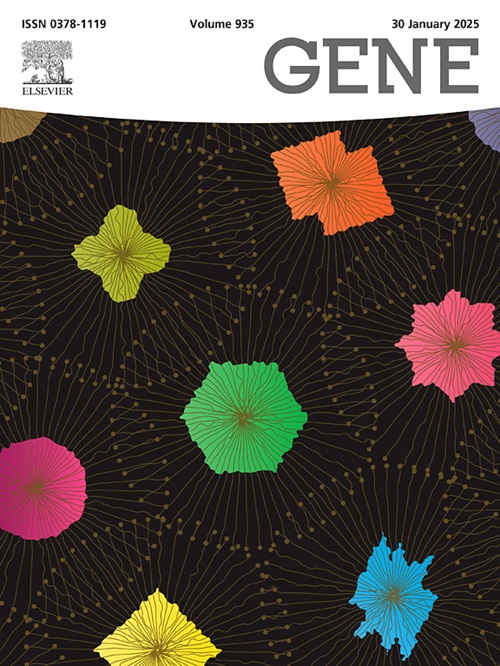METTL3/IGF2BP3通过n6 -甲基腺苷修饰介导ORC6,促进胰腺导管腺癌的进展
IF 2.6
3区 生物学
Q2 GENETICS & HEREDITY
引用次数: 0
摘要
胰腺导管腺癌(pancreatic ductal adencarcinoma, PDAC)是全球公认的最致命的肿瘤之一,需要有效的生物标志物来早期诊断PDAC。ORC6是起源识别复合体(ORC)的一个亚基,启动DNA复制并确保基因组的稳定性。先前的研究表明ORC6在多种癌症中具有前致癌作用,但其在PDAC中的作用尚未被研究。方法应用TCGA、GTEx和GEO数据库分析ORC6表达与PDAC患者临床特征的关系。通过体外和体内RNA干扰研究ORC6在PDAC细胞中的作用。接下来,我们通过western blotting、RT-qPCR、RNA免疫沉淀和甲基化RNA免疫沉淀验证了METTL3/IGF2BP3/ORC6轴对PDAC进展的影响。最后,通过转录组分析探讨ORC6对PDAC细胞中p53的影响。结果在PDAC细胞中观察到ORC6水平升高,与较差的临床预后相关。体内和体外实验均表明,ORC6敲低可抑制细胞增殖,促进细胞凋亡。此外,我们证明了METTL3/IGF2BP3通过n6 -甲基腺苷修饰与ORC6 mRNA相互作用,以提高ORC6 mRNA的稳定性。转录组学分析和实验表明,ORC6通过抑制p53丝氨酸-15磷酸化促进PDAC进展。结论本研究证实了ORC6在PDAC中的作用,并支持了METTL3/IGF2BP3/ORC6/p53轴可能是PDAC新的治疗靶点的假设,抑制该轴可能是治疗PDAC的有利策略。本文章由计算机程序翻译,如有差异,请以英文原文为准。

METTL3/IGF2BP3 mediates ORC6 via N6-methyladenosine modification to promote the progression of pancreatic ductal adenocarcinoma
Background
Pancreatic ductal adenocarcinoma (PDAC) is recognized globally as one of the most lethal tumours, and effective biomarkers to diagnose PDAC early are needed. ORC6, a subunit of the origin recognition complex (ORC), initiates DNA replication and ensures genomic stability. Previous studies have indicated that ORC6 is procarcinogenic in various cancers, yet its role in PDAC remains uninvestigated.
Methods
We evaluated the relationships between ORC6 expression and the clinical features of patients with PDAC with the TCGA, GTEx, and GEO databases. The role of ORC6 in PDAC cells was explored by RNA interference in vitro and in vivo. Next, we verified the effect of the METTL3/IGF2BP3/ORC6 axis on PDAC progression by western blotting, RT-qPCR, RNA immunoprecipitation, and methylated RNA immunoprecipitation. Finally, transcriptome analysis was performed to explore the influence of ORC6 on p53 in PDAC cells.
Results
Elevated ORC6 levels were observed in PDAC cells, which correlated with poorer clinical outcomes. Both in vivo and in vitro experiments demonstrated that ORC6 knockdown suppressed proliferation and promoted apoptosis. Additionally, we demonstrated that METTL3/IGF2BP3 interacted with ORC6 mRNA via N6-methyladenosine modification to improve ORC6 mRNA stability. Transcriptomic analysis and experiments indicated that ORC6 promoted PDAC progression by inhibiting serine-15 phosphorylation in p53.
Conclusion
Our findings validate the role of ORC6 in PDAC and support the hypothesis that the METTL3/IGF2BP3/ORC6/p53 axis may be a novel therapeutic target for PDAC, and inhibiting this axis may be an advantageous therapeutic strategy for curing PDAC.
求助全文
通过发布文献求助,成功后即可免费获取论文全文。
去求助
来源期刊

Gene
生物-遗传学
CiteScore
6.10
自引率
2.90%
发文量
718
审稿时长
42 days
期刊介绍:
Gene publishes papers that focus on the regulation, expression, function and evolution of genes in all biological contexts, including all prokaryotic and eukaryotic organisms, as well as viruses.
 求助内容:
求助内容: 应助结果提醒方式:
应助结果提醒方式:


